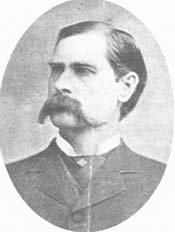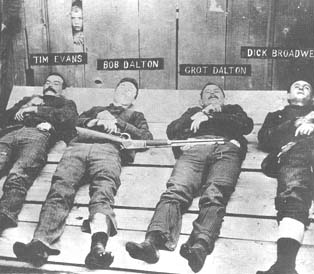|
|
|


|
Wyatt Earp arrived in Wichita in 1874 and applied to be a policeman. He left under somewhat of a cloud (sort of 'asked to leave') and headed for Dodge City in 1876. |
|
|
|
|
In January 1876 in Sweetwater, Texas, he killed a man and a dance-hall girl in a quarrel and fled back to Dodge City where he spent the next ten years, becoming sometime Ford county sheriff (1877-79) and deputy U.S. marshal (1879) identified with the local town bosses known as "the Gang," but working mostly as saloonkeeper and gambler. He made visits to other western towns, including Tombstone, AZ, where he briefly worked with Wyatt Earp at the Oriental Saloon. He ended his Western days in plush Denver gambling houses (1887-1902), until reform-minded citizens asked him to leave. Masterson's final years were spent in New York City, where he was successively deputy U.S. marshal for the southern district of New York (appointed by President Theodore Roosevelt), feature writer for Human Life Magazine, and a prominent sports editor for the New York Morning Telegraph. On October 25, 1921 he died at his desk of a heart attack. |
|
|
The man who became marshal of Abilene, Kansas, on April 15, 1871, was deadly in a confrontation. 1871 Abilene may well have been the toughest town in the West and Hickok's reputation as a marksman gave rise to legends and tales about his life. This American frontiersman, army scout, marksman, and gambler became an American legend. (Hickok Page) |
|
|
In December 1880 he was captured by Sheriff Patrick Floyd Garrett and stood trial for murder in Mesilla, N.M., in April 1881; he was found guilty and sentenced to hang. He escaped jail on April 30, however, killing two deputies, and remained at large until tracked down and ambushed by Garrett, who shot him dead on the evening of July 14, 1881 at the ranch home of Pete Maxwell. Billy the Kid's grave is in Fort Sumner, N.M. Garrett's trails continued to the Roswell area, where he made his home. He made trails to the gold and turquoise mines in the Jicarilla Mountains, he followed the trails of Albert Fountain, trying to solve his mysterious disappearance. On the trail from Organ to Las Cruces, Pat Garrett met his death, in 1908, and is buried in the Masonic cemetery in Las Cruces. Another hypothesis is that Billy the Kid was in fact Ollie L. "Brushy Bill" Roberts, who escaped, lived in Mexico and the U.S. Southwest, rode in Wild West shows, and died in 1950 in Hico, Texas.
|
|
 |
|
~~~~~~~~~~~~~~~~~~~~~~~~~~~~~~~~~~~~~~~~~~
Where We Critters Live
Kansas || Wichita
Kaws ||
Wichitas
|| Plains Indians
The Infamous || Tornado!
~~~~~~~~~~~~~~~~~~~~~
New Hampshire || Lake Winnipesaukee
The Abenaki || Alton Bay
Main
SiteGuide
Avian
Critter || Canine Critter
|| Human Critters
Beanie Critters || Wild
Critters
Interests & Hobbies & Links, Oh My!
~~~~~~~~~~~~~~~~~~~~~~~~~~~~~~~~~~~~~~~~~~
background by me
Papagei
Studios
___________________________________________________